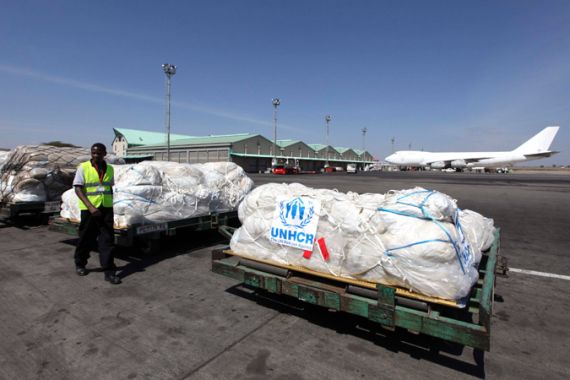First UN aid drops reach rebel-held Somalia
Medicine and food are airlifted to territory held by al-Shabab after opposition group lifts ban on foreign agencies.

The United Nations has delivered food and medicine to displaced and malnourished Somalis for the first time in territory held by the opposition movement al-Shabab.
The UN Children’s Fund (UNICEF) on Sunday airlifted emergency nutrition supplies and water equipment to the town of Baidoa, in south-central Somalia, after the movement, which controls most of the country, lifted its ban on foreign aid organisations.
Keep reading
list of 4 items‘Mama we’re dying’: Only able to hear her kids in Gaza in their final days
Europe pledges to boost aid to Sudan on unwelcome war anniversary
Birth, death, escape: Three women’s struggle through Sudan’s war
The delivery included five tonnes of food and medicine to treat severely malnourished children as well as equipment to supply clean water for a camp near Baidoa that houses refugees.
The UN also said it would send supplies to Mogadishu, the capital controlled by the internationally recognised Transitional Federal Government.
Those supplies will include kits with essential medicine to treat childhood illnesses such as respiratory tract infections, diarrhoea and worm infestations in up to 100,000 people for three months.
Al-Shabab, an armed movement that aims to overthrow the government and impose Sharia law, banned foreign aid organisations in 2010 after imposing a tax on the organisations the prior year that analysts said was aimed at funding their war effort.
But with international attention turning to Somalia and the Horn of Africa as the region experiences its worst drought in 60 years, al-Shabab recently lifted that ban, and the UN’s World Food Programme has said it is ready to work again in areas controlled by the movement.
Worst crisis ‘in a generation’
UNICEF says about 11 million people need humanitarian assistance in the Horn of Africa.
The organisation estimates that about 500,000 Somali children face life-threatening conditions that could have long-lasting consequences for their physical and mental development.
East Africa’s hunger crisis has been described by a US official as one of the worst humanitarian crisis in decades, amid stepped-up efforts by Western countries to provide relief aid and a decision by Kenya to open a fourth camp for starving refugees.
Tens of thousands of Somali refugees are flooding camps in Ethiopia and Kenya – at a rate of more than 3,000 new arrivals per day – in search of food after several seasons without rain killed livestock and destroyed crops in Somalia.
“There are many seasoned relief professionals who would tell you we haven’t seen a crisis this bad in a generation,” Reuben Brigety, the deputy assistant secretary responsible for state department assistance to refugees and conflict victims in Africa, said on Saturday.
“We anticipate that this crisis will get worse before it gets better.”
The US was studying how much more it would give in addition to $5m promised on Friday to help Somali refugees, on top of a previously budgeted $63m, Brigety said.
For its part, Germany said it is donating an additional $7m in humanitarian aid.
‘Great worry’
Dirk Niebel, the German development minister, said in Berlin on Saturday that “the famine and the humanitarian crisis in the Horn of Africa are a cause of great worry”.
| In Video |
|
Robert McCarthy, a UNICEF emergency adviser in Nairobi, discusses the humanitarian crisis |
He said the emergency aid is in addition to the $5m pledged by Berlin earlier this year.
Duncan Harvey, the acting country director for Save the Children in Ethiopia, said: “In terms of the sheer numbers of people affected, this is one of the worst droughts the world has seen in a long time.”
A senior UN official warned on Saturday that the plight of millions of people left hungry was set to worsen, with the next rains expected in October and harvests months away.
“We are possibly seeing a perfect storm in the coming months … We are going to do everything we can to ameliorate it,” Anthony Lake, the UNICEF director, told the AFP news agency on his way to the drought-hit northern Kenya region of Turkana.
“We are scaling up in every way we can … It is very bad now. There will be no major harvests until some time next year.
“The next six months are going to be very tough.”
Official’s account
Over the last several days, Brigety has visited several camps in Ethiopia and Kenya, and talked to mothers and children who walked for days with little food or water.
Levels of malnutrition among refugees arriving at the camps are very high.
The overall mortality rate at the camps in Ethiopia is seven people out of 10,000 per day, when a normal crisis rate is two per day, Brigety said.
At Kenya’s Dadaab refugee camp, the largest in the world, Brigety spoke to a mother who arrived at the camp with six children, including a seven year old who has polio, that she carried on her back.
The crisis has swelled Dadaab’s numbers to nearly 440,000 people, the UNHCR said on Friday.